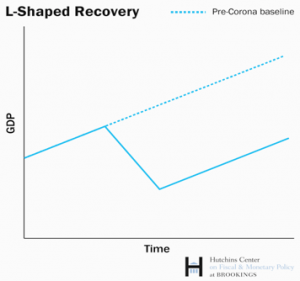The devasting economic recession we now face is not news to anyone. We all know someone who is now out of work and struggling with living expenses. We all see shuttered local businesses, many uncertain of their futures, and often facing the prospects of bankruptcy. This is economic devastation.
We are less certain of what the economic future holds. Will the economy rebound or will it continue in free fall. How long will it take to come back? Must we get used to a new normal with higher unemployment, lower gross domestic products, and stagnant wages?
A number of studies from leading economists and organizations have offered various pictures of our future. Some are more optimistic than others.
No one knows for certain which picture will eventually emerge. We do know that the length of the pandemic is what drives optimism and pessimism, and the length of the pandemic is determined by both our success in controlling the virus and the time to develop a vaccine.
The economic future may look like one of the following scenarios, as described by David Rodeck in the April 19, 2020 edition of Forbes. He summarizes the four pictures of what our future could be. They include the V, U, W and L shaped recessions.
The V-shaped model

The V shape depicts the most optimistic view of the future. The V depicts a return to pre-virus levels in as soon as 2 quarters. This shape assumes control of the virus in short order, businesses opening, and an end to social distancing. The model is also driven by the assumption that pent up consumer demand will give quick buoyancy to the economy. While demand may be indeed pent up, the model assumes that consumers will have money to spend as the virus weakens. The level of unemployment and depletion of family income and savings may invalidate these assumptions. Rodeck reports that 38% of companies see this model as most likely.

The U-shaped model
Like the V-shaped model, the U-shaped depiction shows a return to pre-COVID economic health, albeit delayed. The U-shaped model suggests that it will take perhaps 2 years for the economy to recover. Underlying the U model is the notion that a vaccine will not be available until early 2021. The number of bankruptcies and stagnant consumer spending will impact the duration of the recession. If these factors increase, the time to recovery will also increase. According to Rodeck, 54% of companies see this recovery model as likely.

The W-shaped model
The W-shaped model is more pessimistic. This depiction sees an initial surge in economic activity and much like the V model. However, delays in finding a vaccine, or ill-effects of opening up communities too early will bring about a second wave of infection leading to another economic crisis. The first spike in economic activity may come in 2 quarters, then collapse for perhaps a year before returning to pre-pandemic levels. This model has gained credibility as the development of a vaccine lags, social distancing is reduced, and there are increasing number of undiagnosed infections that perpetuate the pandemic.

The L-shaped model
The L-shaped model offers the most pessimistic prediction of our economic future. It depicts a protracted economic recession that could last years. According to this model, the economy will continue to suffer long-term as the result of the following factors.
First, declining investment.
Second,loss of productivity.
Third, ongoing disruptions in global supply chains.
Fourth, wage decline or stagnation, growing bankruptcies both personal and corporate.
Fifth, a diminished quality workforce as the result of impacts on the educational system and workforce development.
All of these factors are the result of little or no progress in controlling the virus and/or ineffective government programs and abatement efforts.
Only 8% of businesses see the L-shaped model as most likely.
Determinents to consider
Rodeck reminds us that some economists are more optimistic, citing the strength of the pre-virus economy. Factors such as pre-virus productivity gains, a world-class workforce, low unemployment, and healthy GDP provide a strong backdrop to the COVID crisis, one we can leverage through gradual re-opening of the economy, leading us out of the recession.
A recent study by the consulting firm McKinsey identifies the underlying determinants of any economic recovery:
First, the impact of the virus on any area. The health of a region’s economy is obviously linked to the number of COVID cases.
Second, the strength of health care systems to detect and treat viral cases.
Third, the development and successful implementation of governmental programs and economic recovery strategies.
Missteps associated with any of these fundamental factors will jeopardize the economic recovery.
Dr. Jan Hillard is senior editor/data-based reporting for the NKY Tribune and Emeriti Faculty, retired, of Northern Kentucky University.
















